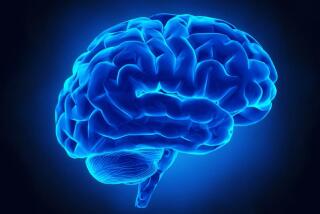UCI Research Yields Clue to Schizophrenia
- Share via
IRVINE — Seeking the cause of devastating mental illnesses, UC Irvine psychiatrist Monte S. Buchsbaum has mapped areas deep in the brain that are active in normal people but inactive in schizophrenics.
In studies presented recently to the American Psychiatric Assn. in New York, Buchsbaum reported that when a sensory area of the brain called the thalamus is highly active in normal people, the frontal lobe of the brain is active as well.
But in schizophrenics, Buchsbaum said, “the more your thalamus is working, the more your frontal lobe is turned off. So there is something developmentally wrong--or chemically wrong” with the brain circuitry of schizophrenics.
Buchsbaum is hopeful that future drug therapies can correct this abnormality, enabling some schizophrenics to live more normal lives.
About 2% of Americans--about 5 million people across the country, 46,000 in Orange County--have schizophrenia, an incapacitating, lifelong disease that usually begins in adolescence and is characterized by disordered thinking, apathy and, frequently, hallucinations.
Considered among the nation’s pioneers in this research, Buchsbaum and his colleagues at UCI’s 6-year-old Brain Imaging Center have been studying schizophrenia, Alzheimer’s disease and affective disorders such as depression using a Positron Emission Tomography scanner (Petscan), a brain imaging device that measures the metabolism of the brain after an injection of radioactive glucose.
Based on this work, Buchsbaum now believes that there are actually several kinds of schizophrenia--one disease caused by genetic defects, others resulting from a virus attacking the brain in early childhood or in the second trimester of fetal development, when what he calls “the long connections between different brain areas” are made.
His recent work adds to a growing body of scientific evidence showing that brain abnormalities, rather than social conditions, cause schizophrenia.
In the mid-1960s, a study of Danish twins who were adopted by different families but still became schizophrenic showed a genetic basis for the disease. After that, Buchsbaum said, the major question for researchers in the early 1980s became: “What is it that causes schizophrenia?” With the advent of Petscanning, their focus has narrowed to what part of the brain causes schizophrenia. Though a complete explanation still eludes them, researchers are now closing in on the answers, Buchsbaum said.
His latest findings come from a 20-month-long study of 18 schizophrenics who had never received neuroleptic medication for their illness.
He and several other nationally known brain researchers call it the largest study of its kind and one that decisively shows that brain activity in schizophrenics is radically different from that in normal subjects.
Until now, the notion had been hard to prove, Buchsbaum said, because most studies involved schizophrenics who had been medicated for their illness. Critics had complained that the subjects’ brain activity may have been altered by drugs used to treat their psychosis.
But in all 18 of Buchsbaum’s never-medicated but moderately ill schizophrenics, Petscans showed greatly reduced activity in the frontal lobes when the thalamus was active--the opposite of normal subjects.
In addition, the scans showed that activity in the thalamus of schizophrenics is apparently a drain on energy in their frontal lobes, Buchsbaum said. In normal subjects, a correlation between activity in the thalamus and frontal lobe produced a value of .40. But when activity in the thalamus and frontal lobe was correlated in schizophrenics, the result came in a negative number, Buchsbaum said: -.63.
In related work, Buchsbaum and his colleagues at the Brain Imaging Center are trying to predict whether schizophrenics with different brain deficits will respond better to certain drugs.
“This is our hope--to treat schizophrenics differently from one another,” Buchsbaum said.
Up to now, he said, drug manufacturers have not differentiated between several different kinds of schizophrenia when they have performed their studies, he said.
The emphasis in diagnosing and treating the disease has been on sorting out schizophrenics by their symptoms. But Buchsbaum believes that researchers need to sort out schizophrenics differently: “by their different kind of brains.”
For instance, brightly colored Petscans can show that the basal ganglia--a collection of neurons located in the cerebellum--may look “hot,” or very active, in one person with schizophrenia but cool, or very inactive, in another schizophrenic, he noted.
In an upcoming study with 50 subjects, Buchsbaum hopes that brain scans will help predict which patients will do well on a conventional neuroleptic drug, thioxine, and which patients might be more responsive to a new drug, Clozapene.
Added psychologist Richard Haier, associate director of the Brain Imaging Center, “Petscan is showing that different parts of the basal ganglia potentially can predict” which kind of drug a patient will best respond to. “This is very new,” he said.
Buchsbaum is not optimistic that his research will lead to a cure for schizophrenia.
Asked about that, he responded: “Is insulin a cure for diabetes? We’re looking for ways to manage the illness,” to allow schizophrenics to return to society and to improve the quality of their lives.
Buchsbaum’s interest in schizophrenia is mainly scientific. To the best of his knowledge, none of his relatives has ever had the disease. Rather, he became fascinated by schizophrenia in medical school at UC San Francisco in the mid-1960s because of its complexity and because of the opportunity for research. “When I began research as a medical student, it seemed to me the most interesting scientific puzzle,” he said.
Shortly after his residency, Buchsbaum joined the National Institute of Mental Health, where he became one of the first scientists in the world to use the new Petscan technology to examine brain activity in schizophrenics.
Though his primary interest is research, in many ways his exploration into schizophrenia has affected his life, Buchsbaum acknowledged. He has become friendly with the families of some schizophrenics, and many of these are now major financial backers of UCI’s Brain Imaging Center. His wife has edited a national journal on schizophrenia, Schizophrenia Bulletin, for many years.






